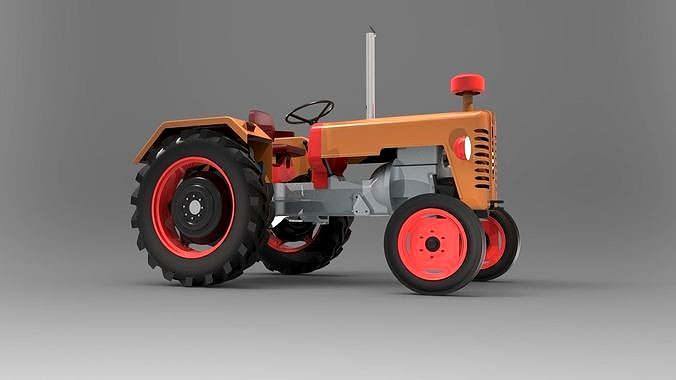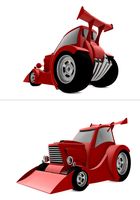CG Trader

Tractor
by CG Trader
Last crawled date: 1 year, 9 months ago
A tractor is an engineering vehicle specifically designed to deliver a high tractive effort (or torque) at slow speeds, for the purposes of hauling a trailer or machinery such as that used in agriculture, mining or construction. Most commonly, the term is used to describe a farm vehicle that provides the power and traction to mechanize agricultural tasks, especially (and originally) tillage, and now many more. Agricultural implements may be towed behind or mounted on the tractor, and the tractor may also provide a source of power if the implement is mechanised. The first powered farm implements in the early 19th century were portable engines – steam engines on wheels that could be used to drive mechanical farm machinery by way of a flexible belt. Richard Trevithick designed the first 'semi-portable' stationary steam engine for agricultural use, known as a barn engine in 1812, and it was used to drive a corn threshing machine. The truly portable engine was invented in 1893 by William Tuxford of Boston, Lincolnshire who started manufacture of an engine built around a locomotive-style boiler with horizontal smoke tubes. A large flywheel was mounted on the crankshaft, and a stout leather belt was used to transfer the drive to the equipment being driven. In the 1850s, John Fowler used a Clayton & Shuttleworth portable engine to drive apparatus in the first public demonstrations of the application of cable haulage to cultivation. In parallel with the early portable engine development, many engineers attempted to make them self-propelled – the fore-runners of the traction engine. In most cases this was achieved by fitting a sprocket on the end of the crankshaft, and running a chain from this to a larger sprocket on the rear axle. These experiments met with mixed success. The first proper traction engine, in the form recognisable today, was developed in 1859 when British engineer Thomas Aveling modified a Clayton & Shuttleworth portable engine, which had to be hauled from job to job by horses, into a self-propelled one. The alteration was made by fitting a long driving chain between the crankshaft and the rear axle. The first half of the 1860s was a period of great experimentation but by the end of the decade the standard form of the traction engine had evolved and changed little over the next sixty years. It was widely adopted for agricultural use. The first tractors were steam-powered plowing engines. They were used in pairs, placed on either side of a field to haul a plow back and forth between them using a wire cable. In Britain Mann's and Garrett developed steam tractors for direct ploughing, but the heavy, wet soil of England meant that these designs were less economical than a team of horses. In the United States, where soil conditions permitted, steam tractors were used to direct-haul plows. Steam-powered agricultural engines remained in use well into the 20th century until reliable internal combustion engines had been developed. vehicle farmer farming land transport wheel rim tire machine diesel engine truck
Similar models
cg_trader
$16

Tracktor
...leworth portable engine to drive apparatus in the first public demonstrations of the application of cable haulage to cultivation.
cg_trader
$12

Tractor
...e truck heavy trailer transport excavator plowing plough plow vehicle industrial industrial vehicle tractor trailer truck trailer
cg_trader
$14

Cabin tractor
...implement is mechanised. farm vehicle tractor agriculture village farmer rural plough plow villager industrial industrial vehicle
grabcad
free

Tractor
...may be towed behind or mounted on the tractor, and the tractor may also provide a source of power if the implement is mechanised.
grabcad
free

Tractor Model
...may be towed behind or mounted on the tractor, and the tractor may also provide a source of power if the implement is mechanised.
grabcad
free

TRACTOR
...may be towed behind or mounted on the tractor, and the tractor may also provide a source of power if the implement is mechanised.
cg_trader
$11

Tractor Low Poly and High Poly
...may be towed behind or mounted on the tractor, and the tractor may also provide a source of power if the implement is mechanised.
cg_trader
$99

Self-Driving Drone Tractor New Rigged
...arm engineering, harvest machinery, industrial harvesting agriculture, and construction machinery designing promotional projects.
cg_trader
$2

Tractor tyre
... large truck industrial tool farming barn plowing rim seeder john deer nologo country countryside industrial vehicle tractor tire
cg_trader
$11

tow tractor
... industrial car towed tow truck towing cargo transport heavy other ascifi stylized color pushback exterior sci fi sci fi exterior
Tractor
3d_export
$4

tractor
...tractor
3dexport
tractor
archibase_planet
free

Tractor
...ractor
archibase planet
tractor agrimotor wheeled tractor
tractor n110113 - 3d model (*.gsm+*.3ds) for exterior 3d visualization.
archibase_planet
free

Tractor
...ractor
archibase planet
tractor agrimotor wheeled tractor
tractor n120614 - 3d model (*.gsm+*.3ds) for exterior 3d visualization.
archibase_planet
free

Tractor
...ractor
archibase planet
tractor agrimotor wheeled tractor
tractor n250614 - 3d model (*.gsm+*.3ds) for exterior 3d visualization.
archibase_planet
free

Tractor
...
archibase planet
tractor agrimotor wheeled tractor
tractor n110314 - 3d model (*.gsm+*.3ds+*.max) for exterior 3d visualization.
3d_ocean
$29

tractor
...r farm tractor traktor truck
create tractor on 3d max, maya, ojb, and fbx, in addition to texture ( diffuse, bump and specular ).
3d_ocean
$19

F1 Tractor
...f1 tractor
3docean
f1 futuristic race tractor red tractor
simple futuristic race tractor model.
3d_export
free

cartoon tractor
...cartoon tractor
3dexport
cartoon tractor
turbosquid
$49

Tractor
...turbosquid
royalty free 3d model tractor for download as max on turbosquid: 3d models for games, architecture, videos. (1668446)
turbosquid
$30

tractor
...turbosquid
royalty free 3d model tractor for download as max on turbosquid: 3d models for games, architecture, videos. (1320695)
